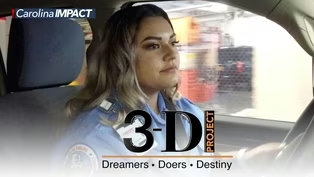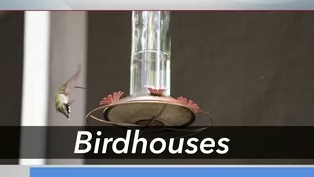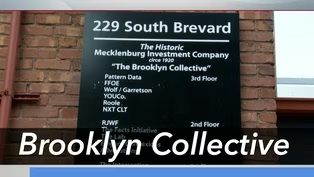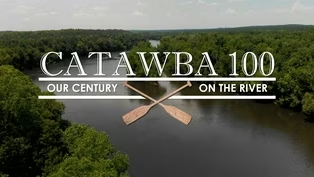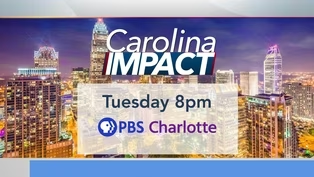
Carolina Impact: September 14, 2021
Season 9 Episode 2 | 24m 53sVideo has Closed Captions
Brooklyn Collective, 3d Project Alumni, Catawba 100 Lake Rhodhiss and Birdhouses
A Charlotte couple transforms the remnants of the Historic Brooklyn Community into the Brooklyn Collective - a space for arts and business. An EMT realizes her dream thanks to a unique program for high school seniors, and meet the woodworker redirecting his passion for building homes to designing birdhouses.
Problems playing video? | Closed Captioning Feedback
Problems playing video? | Closed Captioning Feedback
Carolina Impact is a local public television program presented by PBS Charlotte

Carolina Impact: September 14, 2021
Season 9 Episode 2 | 24m 53sVideo has Closed Captions
A Charlotte couple transforms the remnants of the Historic Brooklyn Community into the Brooklyn Collective - a space for arts and business. An EMT realizes her dream thanks to a unique program for high school seniors, and meet the woodworker redirecting his passion for building homes to designing birdhouses.
Problems playing video? | Closed Captioning Feedback
How to Watch Carolina Impact
Carolina Impact is available to stream on pbs.org and the free PBS App, available on iPhone, Apple TV, Android TV, Android smartphones, Amazon Fire TV, Amazon Fire Tablet, Roku, Samsung Smart TV, and Vizio.
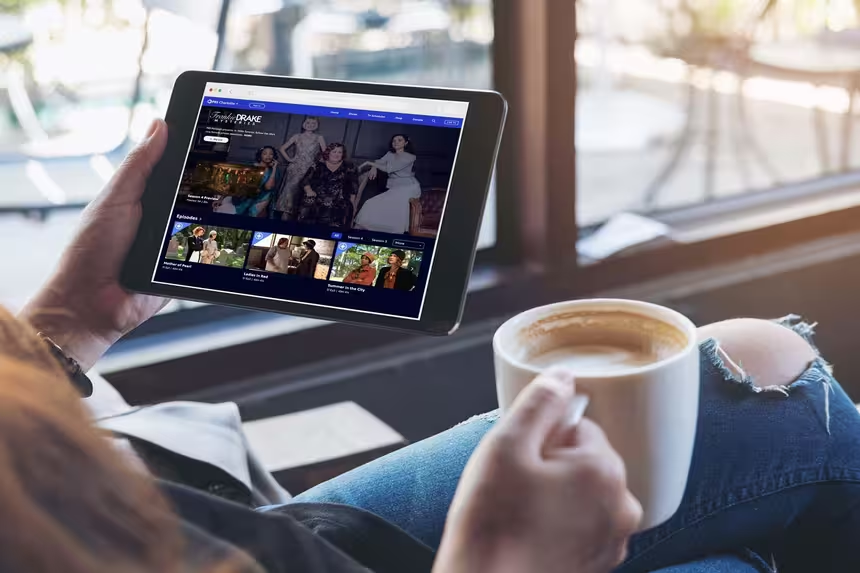
Introducing PBS Charlotte Passport
Now you can stream more of your favorite PBS shows including Masterpiece, NOVA, Nature, Great British Baking Show and many more — online and in the PBS Video app.Providing Support for PBS.org
Learn Moreabout PBS online sponsorship- [Announcer] This is a production of PBS Charlotte.
- Just ahead on Carolina Impact, a Charlotte couple turns the remnants of a building in a historic black community into a hotspot for businesses and the arts.
Plus a young EMT living her dream.
Learn about the program that helped her turn her dream into a reality.
And from big houses to bird houses, meet the retired Charlotte woodworker using recyclables to create teeny tiny works of art.
Carolina Impact starts right now.
- [Announcer] Carolina Impact, covering the issues, people, and places that impact you.
This is Carolina Impact.
- Good evening, thanks so much for joining us.
I'm Amy Burkett.
It was once referred to as Charlotte's Black Wall Street, the Brooklyn Community, a thriving African American neighborhood in the heart of uptown Charlotte, made up of more than 1400 homes, and 200 businesses.
Urban renewal ushered in the demise of Charlotte's Brooklyn Community in the sixties, but now a new effort to revitalize its remnants, spearheaded by Monique and Kevin Douglas.
The goal to revive the only remaining buildings as a collective that not only fosters the arts, but nurtures diversity in business and community service.
Beatrice Thompson takes us on a journey of The Brooklyn Collective.
(whoosh) - [Beatrice] An artist who sees the world in colors, a nonprofit that finds employment for the disabled, a designer whose inspiration comes from a black samurai warrior, and a photographer who captures not just faces, but mentors others, not exactly a portrait of corporate America, but it's exactly what The Brooklyn Collective is all about.
Housed in three buildings on Brevard Street, Monique Douglas says this reincarnation of the block builds on the concept that was begun by the black founders more than 100 years ago.
- It was the first African-American financed, designed, and occupied office building in the city of Charlotte, actually an incubator for small businesses, where they were providing resources and support to help these businesses scale and grow.
And we've gone back to that model today, and incubating nine small businesses and nonprofits.
- So I started advocations to help people with disabilities gain access to real job opportunities in Charlotte and beyond.
- [Beatrice] For Lindsay and her clients, this space allows the inclusion of all the concerns of the disabled.
- [Lindsay] Brooklyn Collective gives me kind of the space to be around people that are always challenging the status quo, and it inspires me to think differently, and make sure that I'm doing as much as I can to really make a difference in the Charlotte community.
- We about community, we are a collective of people that are like-minded, or we look out for each other's interests, and we look for opportunities to collaborate.
- [Beatrice] A self-taught photographer, his business at Studio 229 on Brevard also provides space for poets, and more.
As one of the innovators of this concept, Kevin Douglas points out The Collective's responsibility to the next generation.
- [Kevin] In this space, we will mentor, or teach, but I think most of all, we'll provide opportunities.
- I was inspired by a story about the first African samurai named Yasukuni.
- [Beatrice] For a designer-embroiderer Gordon Holliday, this space allows him to expand his business.
- I really sat down and creatively thought, "I wonder what a African samurai would wear in 2021?
What is like, the contemporary style of that?"
And I re-imagined those looks on the runway.
- [Beatrice] This millennial's business is also green, with recycling at its heart.
- For example, this was a hoodie.
This mesh on the front was a football jersey.
These are upholstery fabrics.
(upbeat music) - [Beatrice] The Brooklyn Collective has also nurtured a budding talent, uncovered during a nationwide protest.
- When the riot started June 10th, I kept seeing so many different darker colors.
- [Beatrice] The young artist was about to spray paint the side of one of The Collective's buildings when he was approached by The Collective's Kevin Douglas.
- Justin was a hidden gem that The Collective only got a chance to polish.
- I wanted to really try to emphasize what I saw as an artist, but in a sense, it was like, I wasn't just the only one who was in that mental space, and I was like, "Well, right now in my mental, I see color."
- [Beatrice] Now he's artist in residence at The Brooklyn Collective, with works exhibited in local museums, and at the Van Gogh exhibit.
The Collective includes space for all types of exhibits.
One currently features frontline workers during the pandemic, as well as open community space.
A partnership with the Blumenthal will eventually utilize the former AME Zion Church as a performing arts center, but there is more work to do.
- The next phase of what we can do, corporate partnerships.
We need to community and corporate to rally around the mission of what we're doing here.
(upbeat music) - [Beatrice] Yet the most important thing The Collective may be doing is providing a diverse environment, and a place where collaboration, culture, and community all meet.
- The Brooklyn Collective really is looking to be that place in our city that, number one, sets an example for what it looks like when people of diverse backgrounds come together for a common good.
- [Beatrice] So pose the question, does a tree grow in Brooklyn?
Well, in Charlotte's Brooklyn, the seeds of a collective have staked a firm root on the future.
For Carolina impact, I'm Bea Thompson.
- Thanks so much, Bea.
For more information about The Brooklyn Collective, head over to our website at pbscharlotte.org.
This weekend, PBS Charlotte premieres our latest living history documentary, Catawba 100: Our Century on the River.
It's a look back and a look forward at how the changing Catawba River has changed our lives.
Tonight, we have a sneak peek, PBS Charlotte's Jeff Sonier, and photographer, Doug Stacker take us to Lake Rhodhiss, with a story about one town's historic moment that the whole world was watching.
(whoosh) (guitar strumming) - Downstream from Lake James, here in Morganton starts a stretch of the Catawba where the river actually works as hard as it plays, where power plants on the Catawba provide electricity, where filtration plants on the Catawba provide drinking water, and where industrial plants on the Catawba have provided jobs for generations.
(water flowing) - The river works hard, and we try to mitigate as many impacts as we can as users of the water, so the river doesn't have to do it.
If we don't treat it well, it's not going to provide the livelihoods for everybody forever.
- [Jeff] Brad Boris is Morganton's water resources director.
- We are actually the first water recipient of the water that comes out of Lake James.
We're the first municipality, the first water intake.
Our mission is to manage this resource.
There's a lot of impacts that cause this river to work extra hard, and if there's a point where we're not managing the water resource to treat the water, to make it pristine, high quality, we don't have any excuses.
I want my grandkids, and your grandkids, great grandkids to enjoy it.
And without us doing work now, that's not going to happen.
- [Jeff] Further down the river, near the dam at Lake Rhodhiss, where the Catawba is blue and still, these lifelong river residents remember still, the original Rhodhiss Cotton Mill just below the dam.
The old mill buildings are long gone, but the workers back then were their families and friends.
And now these mill workers' sons and daughters, raised on these waters all have mill town memories, not fading memories, but clear as the river itself.
- John Rhodes and George Hiss built a plant right here.
- [Jeff] Rhodes, Hiss, Rhodhiss.
- Exactly.
- Sherrie Sigman grew up in Rhodhiss.
That's her husband's mother and grandfather in this film from the forties, outside the old brick school house.
And here, above the Rhodhiss Dam at the rock quarry, well, Carl Compton shows us where he dog paddled in the Catawba as a child.
- We was always told, "Don't you go to that river till you learn how to swim."
Well, if you don't go to the river, how, I mean, you know how you going to learn how to swim?
- [Jeff] That's where you learned how to swim?
- Yeah.
- [Jeff] Dog paddle?
- It is, yeah.
- [Sherrie] Back here, you can see the horseshoe-shaped dam, and that trustle washed away in the 1916 Flood.
- [Jeff] Yep, Rhodhiss is another river town filled with those moments and memories.
- [Sherrie] It was a picnic area, and it was one of the train stops.
- [Jeff] Everybody with their own river stories to tell, and re-tell.
- [Carl] That's where I used to take kids when they wanted to go fishing first time.
- [Jeff] But there's also one single moment here in Rhodhiss.
- You know, when everybody read about it, we was excited, you know.
- [Sherrie] They had a big party.
- [Carl] Yeah.
- [Jeff] One shared memory in this river town.
- When we went back to school, elementary school, let me tell you, the kids had something to talk about.
We were proud.
We were very proud.
- [Astronaut] Yep, and they they've got the flag up now, and you can see the stars and stripes on the lunar surface.
- [Carl] The employees didn't know that they were weaving the material for the flag until the company put a notice up on the board, when they landed on the moon.
- [Jeff] Yep, we're floating outside of Old Burlington #2, the other mill in Rhodhiss, across the Catawba, that made the material for the flag that made it to the moon.
Carl was working at the mill back then, so was Sherrie's father.
- Daddy came home, and we were emotional, I'm here to tell you.
I mean, everybody in this town was so proud.
- [Jeff] And today, Rhodhiss is still proud of its moment on the moon.
You'll see the Apollo 11 flag on the Rhodhiss town flag, flying outside town hall, and inside town hall.
well, here's a cutting from the original moon flag fabric, as this river town connects to that historic one small step.
- And our employees were hard workers.
They were dedicated to the job.
- [Jeff] Eventually, even after the recognition of Rhodhiss by NASA for their work on the space program, those jobs disappeared, those hard workers fell on hard times, and those two mills in Rhodhiss, across the Catawba, that employed so many for so long said, "You know, so long."
- You know, these people's coming off the greatest high and achievement that they was going to do in their lifetime.
And then they'll be standing under that rug when it's seemingly pulled right up from under your feet.
- For seven years, all the employees lived in fear, because the first one left, the second one would leave.
- [Jeff] Sherrie still has the photos from those last days at Burlington.
- [Sherrie] Here's my dad right there.
- [Jeff] Her daddy and his longtime coworkers, together on those last shifts.
- It was like a death in the family, and my daddy called me and my daddy cried on the phone.
- I'll have to find myself.
- [Jeff] Carl lost his job at Burlington too.
- [Carl] Let's see, right here.
- [Jeff] The mills in Rhodhiss, just like the river, part of his earliest memories.
- [Carl] When we moved up here, I didn't get to start school till I was seven years old.
- [Jeff] But while the now empty mill, alongside the Catawba, stands as a bittersweet monument to better times, the river itself lives on, and when you live on the river, or fish on the river, or paddle on the river, you realize those better times really never left.
- Okay, now the further up the lake you go, above Castle Bridge, the quieter it gets.
- [Jeff] Because the Catawba is still here, the people are still here, the memories are still here.
(piano playing) - That's just one of the stories you'll see this Saturday night on PBS Charlotte.
Please join us for our newest living history documentary, Catawba 100: Our Century on the River, Saturday, September 18th at seven, only on PBS Charlotte.
Over the last four years, PBS Charlotte has graduated over 600 students in our 3D Project.
Dreamers, Doers, Destiny, that's our seven-week career pathways and leadership economic mobility program.
Tonight, you'll meet just one of them, Selena Cortez, an amazing young woman I'm honored to call my friend.
We've been a part of her journey over the last three years.
Sarah Colón-Harris has her story.
(whoosh) - [Sarah] At 20 Years old, Selena Cortez is living her dream.
- I did not stop until where I'm at right now, and I'm not going to stop.
- [Sarah] The seed first planted after seeing family members get sick.
- When my mom was ill, she would always ride in the back of the ambulance with her, and she said, "Mom, I want to help people."
- [Selena] We get a call from here, and you can hear it from the mic there.
- [Sarah] We first met Selena in 2018, as a student at Garinger High School, a popular athlete, ROTC student, and in her own words- - I was like a teacher's pet.
- [Sarah] Selena, one of more than 600 students who graduated from PBS Charlotte's 3D Project, a seven-week career pathways and leadership program, offered at two Charlotte High Schools, Garinger and Chambers High.
The economic mobility project uses media to encourage students to not only dream, but do so they can reach their destiny.
- My dream is to become a paramedic.
- [Sarah] Students learn about teamwork, problem solving, positive thinking, writing, and public speaking.
As part of the program, Selena researched how to become an EMT, and pushed through nerves to deliver her own I Have a Dream speech in front of her class.
- Saving lives makes me feel like a hero.
I felt really good about myself, but kind of scared, because I'd never been in the big crowd like that, but now I'm like, "This is what I want to be, and this is what I want to do."
- [Sarah] During the program, facilitators helped Selena and other students apply for a two-year opportunity scholarship to Central Piedmont.
For Selena's mom, the full ride came at just the right time.
- I was super stoked that she got it, because we didn't know how she was going to go to college, we couldn't afford it.
We, you know, we didn't have their money for her, and when she came home saying that she received it, it was like a relief.
- [Sarah] Along with the journey, Selena hit a few bumps.
First, the pandemic pushed classes online, then she failed her EMT exam, not once, but twice.
After remembering the advice she heard in the 3D Program, Selena powered through.
- She kept on saying that if it's something that you want to do in life, and something that you love, you'll keep on doing it until you get it, and that's what I did.
- [Sarah] Her fierce determination making her the hero she set out to be.
- She's my hero, she's my best friend, and I'm super proud of her.
- [Sarah] As it turns out, Selena's 2021 graduation also comes at a time where EMTs and paramedics are in high demand.
- So, right now we're having a hard time finding EMTs and paramedics.
We try to have a hiring class about every other month, and I think in Selena's class, we had five, which is unheard of.
So we'd really like to have at least 15 to 20 in those classes.
- [Sarah] Kenny Phillips, Selena's supervisor, believes the shortage is related to the pandemic.
Many people, fearful of the coronavirus, choosing careers outside of healthcare, others simply unaware of the opportunity, and the specifics of the job.
- They assist the paramedic in getting drugs, setting up IVs, setting up the cardiac monitor, assessing vital signs.
They really are really trusted members of the team.
- [Sarah] And did we mention occasionally delivering a baby?
- I mean, people will be like, "Oh my goodness, like blood, all that stuff, and then a woman's giving birth?"
But to me is like, you know what?
You're helping this patient, and you're helping giving birth, and that's like, an amazing thing.
- [Sarah] For Selena, becoming an EMT is just the beginning.
She plans to eventually attend a four year university to become a paramedic, and then eventually study to become a physician's assistant.
She credits the 3D Program for giving her just the boost she needed.
- It helped me, it helped me, my family.
Not only that, but once I had gotten this scholarship, I got like, I met with other people in the community.
The Opportunity Scholarship is all about the community, so it really connected with my job.
- For a program to come along and say, "Hey, we're going to help you," it really changes people's lives.
We are so happy Selena was able to take advantage of that, and that she decided to come here, because she is going to make a difference in a lot of people's lives over the course of her career.
- [Sarah] Making a difference, one emergency call at a time.
For Carolina Impact, I'm Sarah Colón-Harris reporting.
- PBS Charlotte, isn't done helping teens like Selena.
We've got a brand new program starting this fall at Garinger High School.
Well, from Ballantyne to Lake Norman, Dean Forshee's built homes for more than 35 years.
Now in his golden years, he's redirecting his woodworking passion to building much smaller homes for birds.
Today, he uses his old recycled materials to create works of art for our fine feathered friends.
(saw buzzing) - I wouldn't call myself an artist.
I'm very flattered when people refer to me as an artist.
I'm more or less a builder.
(saw buzzing) I always wanted to be a carpenter all my life, and I enjoy working with my hands.
About five years ago, found myself at a loss that I really missed what I did for a living.
Started tinkering out in the shop here with birdhouses, very simple bird houses at that point.
Over a period of about five years, I've sort of developed my skills, and got my hand work like I wanted it to be.
I've started to create birdhouses that are both functional, but some of them are more artistic, and more decorative than functional.
The ideas for my birdhouses come from many different things.
They'll come from things that I see when I'm driving around.
You know, they'll come from pieces of hardware I've collected over the years.
You know, that the shape of the hardware clicked something in my mind that says, "Hey, that'd be pretty neat."
It comes from the type of wood I have on hand at the time.
If you're somebody like me that doesn't like to throw away anything, you tend to collect a lot of stuff, recycled wood, or repurposed wood.
I've got a bird house in the shop there that was made out of chestnut wood that came from my family's farm up in Bowling Green, Kentucky.
It's probably, I would guess, in between 135 to 150 year old.
I've got cherry wood in there that was used in a house I built up at Lake Norman back in the nineties.
Skeleton keys are a popular type of perch, old door knobs, old brass store knobs, or old crystal door knobs out of old houses, basically is what they were.
(saw buzzing) Roofing, I'll use either slate, copper, tin off of old barns.
These things sort of come to you during the process of making the constructions, and it's not something that I sit down and say, "Okay, this is going to be the material.
This is how it's going to be shaped.
This is going to be the roof on it.
This is going to be the perch on it," and then I'll start making it.
It just doesn't happen like that.
It's kind of an organic design, and it's going through my head all the time.
Both my material, my knowledge, and my talent, really, has come from people that, over the years have been generous enough to both provide me with the knowledge, and provide me with the materials to do what I'm doing.
Building a house is basically the same thing that I'm doing right now.
My houses have shrunk dramatically, (chuckling) 99%, but they're the same thing.
I'm building homes, I'm just building homes for birds now, instead of people.
I don't consider these things as works of art.
If other people do, and if other people consider me an artist, very, very flattered to that.
It's not anything that I consider myself.
I consider myself a builder, you know?
Always have been a builder, always will be a builder.
(peaceful music) - I think those birdhouses truly are a work of art.
Well, Dean's work can be seen at the East Side Local Eatery here in Charlotte, and you can also find Dean's contact information on our website.
Well, that's all the time we have for you this evening, my friends.
Thanks so much for joining us.
We always appreciate your time, and look forward to seeing you back here again next time.
Good night.
(upbeat music) - [Announcer] A production of PBS Charlotte.
Video has Closed Captions
Clip: S9 Ep2 | 4m 41s | An EMT realizes her dream thanks to a unique program for high school seniors (4m 41s)
Video has Closed Captions
Clip: S9 Ep2 | 3m 45s | A woodworker redirecting his passion for building homes to designing birdhouses (3m 45s)
Video has Closed Captions
Clip: S9 Ep2 | 5m 20s | Historic Brooklyn Community the Brooklyn Collective - a space for arts and business (5m 20s)
Video has Closed Captions
Clip: S9 Ep2 | 6m 45s | One town’s historic moment that the whole world was watching (6m 45s)
Preview: S9 Ep2 | 30s | A Preview of Carolina Impact: September 14, 2021 (30s)
Providing Support for PBS.org
Learn Moreabout PBS online sponsorship
- News and Public Affairs

Top journalists deliver compelling original analysis of the hour's headlines.

- News and Public Affairs

FRONTLINE is investigative journalism that questions, explains and changes our world.












Support for PBS provided by:
Carolina Impact is a local public television program presented by PBS Charlotte
